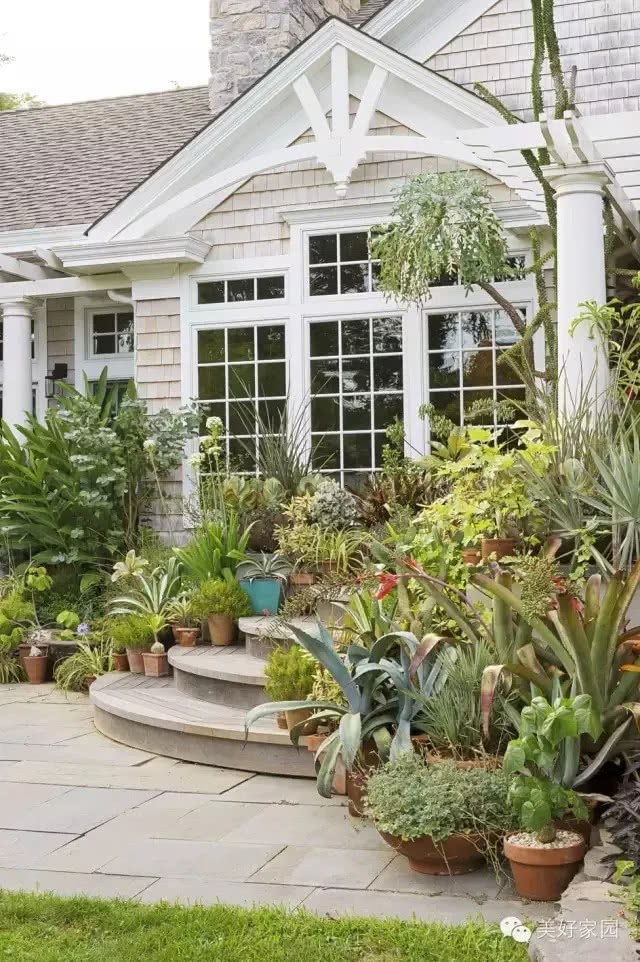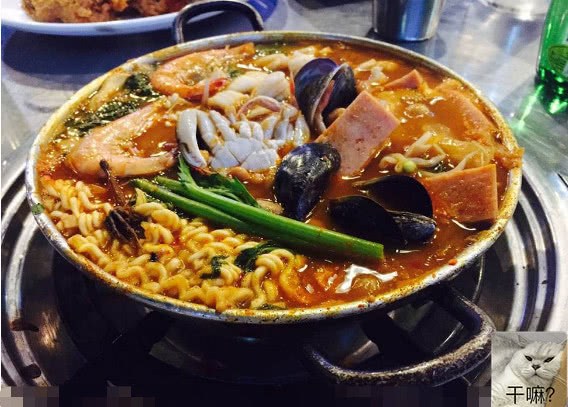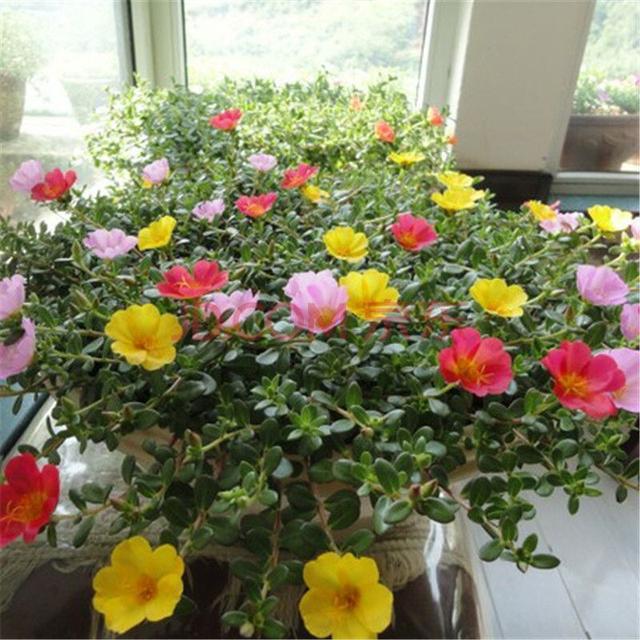Pot master Dennis combines more amazing plants to produce more vivid potted works.

At first, his wish was that the garden could hold all the potted plants, but the "tropical storm" finally swept his mind.
It turns out that plant sellers are as crazy as buyers, addicted to collecting plants, and look at nearly 40 pots of plants on both sides of the steps, including tequila, pineapple, bulbs, pot-shaped plants and other bizarre varieties.
When he first met Dennis Schrader, he tried to put in a good word for potted plants with mixed styles. As a master of potted plants, he didn't mean to offend other ways of organizing pots. The pots principle of "protagonists, supporting roles and overflow plants" may be a little too dogmatic. On the contrary, Dennis likes to combine more amazing plants to produce more vivid potted works. Dennis, who fell in love with tropical plants uncontrollably, said it took only a short time for his interest to form.
A tiger-eyed evergreen is the main plant on the steps, and behind it are kangaroo claw flowers and many varieties of tequila.
In 1982, Dennis became a partner in the landscape design business, interpreting the beauty of tropical plants in his personalized style. They are eager to exploit as many tropical plant resources as possible, but the gap between ideal and reality forces them to wake up finally. Ten years later, they adjusted their business strategy and moved to Mattituck on long Island and set up Landcraft Environment Co., Ltd., a nursery specializing in the cultivation and wholesale of rare perennials. Since then, Dennis has joined the ranks of world-class plant variety collectors, and their private garden next to the nursery has naturally become the frontline of strange plants from all over the world.
Simple and powerful, the round-leaf tiger tail orchid protrudes a round leaf sword from the cushion-shaped gray-green cold spray "aquamarine", while the spread of goldfish grass continues to bloom.
How to make good use of the spiritual wealth of plants? Potted plants are obviously the best way to show off. Dennis focuses on potted combinations of a single kind of plant, but most of these potted plants are not a monologue, and they are often featured by a major plant along with other plants. Usually Dennis will find a plant with vertical lines to occupy the dominant position of the pot, and then set a circle of ground cover around it, mostly tiny, hanging plants. Perhaps it is the combination of tall and straight tiger tail orchid and surrounded by cold water, or it may be the combination of tiger eye evergreen and creeping goldfish grass. Although there is only one bright spot to show off in each pot, Dennis is accustomed to using similar plants around the main plant, which is comparable in number to the traditional mash-up style potted plants, but has more primary and secondary levels.
The golden leaves overflowed out of the flowerpot, and on both sides of the pot were colored leaf taro "King Arthur Divine Sword" and Wu Fengcao "floating Cloud Brocade".
Dennis's method is suitable for plants with strong vertical lines in the main plant but little interest in the lower half, so to some extent, the effect of solving thorny problems is obvious. Dennis's potted plants skillfully cover the bare land around the house and in the garden, while accurately capturing the most beautiful side of the plant. Compared with the potted combination with mash-up style, the characteristics of the combination of single species of plants are more prominent.
The main potted plant draws gray inspiration from the stone, as well as silver leaf Xiyang Maran and tree-shaped lavender cotton (silver chrysanthemum). The tiger tail orchid and the optical fiber grass dotted along the steps form a sharp contrast with them.
Of course, the selection of plants also has a certain influence. The color of pots is also closely related to the color of plant stems, such as black-stemmed taro, small gray-green cold spray "aquamarine" and dark blue pots; tall and slender pots can set off the slim shape of the main plant. Either way, you should choose the basin carefully. After all, it is an integral part of the work.
The "three cobblers" are the water tower flowers as the main plant, the clump-shaped Tang seal of the crassulaceae, and the heavy fan of the duckfoot family hanging out of the basin.
The clue of pots is to bring together plants with the same needs and growth habits, taking into account not only the light needs of plants, but also the dry and wet preferences of the soil. In each group of potted plants carefully arranged by Dennis, both sides of the combination have similar or common growth habits. As the plant materials in the pots do not require much light, as long as they are moved indoors in winter, they can live year after year. Compared with the principle of "having protagonists, supporting roles and overflow plants", the whole pot plant of Dennis is a living "protagonist".
Under the vines leading to the vegetable garden, the Lady of Begonia takes root in a tall stone urn, surrounded by flowers and leaves and Ficus pumila.
A potted combination of a single species of plant
Dennis takes the black-stemmed taro, which is straight and similar to the shape of an arrow, as an example to demonstrate how to master the potted combination of a single kind of plant. Paired with the main plant is the gray-green cold spray "aquamarine"-dark stems and tiny silver leaves form a sepiolite-like cushion around the edge of the basin. In terms of pots, Dennis chose a dark blue glazed flowerpot, which is enough to brighten people's eyes.
Prepare materials:
Flowerpots with 35cm diameter (with sufficient depth),
Potted soil,
A black-stemmed taro,
Six gray-green cold spray "aquamarine".
Fill in high-quality potted soil with a depth of a few centimeters below the edge of the flowerpot.
Pull out the black-stemmed taro from the original flowerpot and comb its roots.
Dig a hole and place the black-stemmed taro in a new flowerpot. Pay attention to exposing the root mass above the soil surface.
The soil was backfilled around the root mass of black-stemmed taro, and a wide groove band of 5cm was reserved for cold spray.
Tamp the soil around the root mass.
Crush the cold water plastic flowerpot to help the plant get out of the pot smoothly.
Loosen the soil and comb the roots of the cold spray.
Six cold spray plants were implanted side by side, compacted, and potted soil was added to fill all the gaps.
Arrange the suitable position for the newly prepared potted plant combination, black-stemmed taro and gray-green cold spray "aquamarine" have similar growth habits, both prefer semi-shade. Water the new potted plant and enjoy its beauty.
-END-
New media for a better home
Present every home that you and I can touch!
Classic case of home decoration | authoritative professional gardening instructor
Exquisite lifestyle concept | sharp and trendy art information
- Prev

The facial expression of a well-known food blogger changed seconds after eating 3 yuan vegetarian wonton purchased online.
Live broadcast by a well-known food blogger, eating 3 yuan vegetarian wonton bought online, the expression changes in seconds after tearing open! Instant noodles, as instant food, have been sought after by many people, but because of the popularity of instant noodles, many businesses have found more business opportunities.
- Next

The following two kinds of plants grow wildly without fertilizing for a year and are not afraid of wind and rain.
People who often grow flowers know that the growth characteristics of each kind of flowers are different, so they should be maintained with special care. Of course, we choose potted flowers, it is best to choose those flowers that are not only good-looking, but also easy to grow.
Related
- Wuhan Hospital Iron Tree Blooming Result Was Instantly Frightened by the Gardener Master
- Which variety of camellia is the most fragrant and best? Which one do you like best?
- What is the small blue coat, the breeding methods and matters needing attention of the succulent plant
- Dormancy time and maintenance management of succulent plants during dormancy
- Minas succulent how to raise, Minas succulent plant pictures
- What are the varieties of winter succulent plants
- How to raise succulent plants in twelve rolls? let's take a look at some experience of breeding twelve rolls.
- Attention should be paid to water control for succulent plants during dormant period (winter and summer)
- Watering experience of twelve rolls of succulent plants
- Techniques for fertilizing succulent plants. An article will let you know how to fertilize succulent plants.

